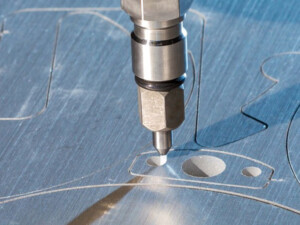
Water Jet Guided Laser Cutting: The Hybrid Technology Revolutionizing Precision Manufacturing
In the relentless pursuit of precision, speed, and quality in material processing, manufacturers continually seek technologies that push the boundaries of what’s possible. While traditional laser cutting and pure waterjet cutting are powerful in their own right, a groundbreaking hybrid technology has emerged that combines their best attributes: water jet guided laser cutting. Also known as laser microjet or water-jet guided laser (WJG) technology, this innovative process merges the intense energy of a laser with the cooling and guiding properties of a low-pressure water jet. This fusion creates a cutting tool of unparalleled precision and capability, addressing many of the limitations inherent in conventional laser processing. For industries where micron-level accuracy and impeccable quality are non-negotiable, understanding water jet guided laser cutting is essential. This comprehensive guide delves into the principles, advantages, applications, and future of this remarkable technology.
What is Water Jet Guided Laser Cutting? The Principle of Total Internal Reflection
Water jet guided laser cutting is a sophisticated hybrid process that fundamentally differs from both standard laser cutting and abrasive waterjet cutting. The core innovation lies in how the laser beam is delivered to the workpiece.
Here’s how it works: A laser generator (typically a pulsed Nd:YAG or fiber laser) produces a laser beam that is focused into a nozzle chamber. Simultaneously, a stream of ultra-pure, deionized water is pumped through this nozzle at a relatively low pressure (around 20-100 bar), much lower than that used in abrasive waterjet cutting. Through precise optical engineering, the laser beam is coupled into this thin water jet, which acts as a “liquid light guide.”
Due to the principle of total internal reflection—the same phenomenon that allows light to travel through fiber optic cables—the laser beam is trapped within the water jet. The water has a higher refractive index than the surrounding air, causing the laser light to reflect off the inner wall of the water stream as it travels. This guided water jet then strikes the workpiece, delivering the laser energy directly to the cut point with incredible stability and precision.
Key Advantages of the Water Jet Guided Laser Process
The unique marriage of laser and water jet bestows water jet guided laser cutting with a set of distinct advantages that are unattainable with either technology alone.
Exceptional Precision and Minimal Kerf: The water jet, typically 50 to 150 microns in diameter, defines a perfectly stable and consistent cutting tool. This allows for extremely narrow kerf widths and the ability to produce intricate features, sharp corners, and micro-scale details with astonishing accuracy. There is no “taper” effect common in traditional waterjet cutting.
Absence of a Heat-Affected Zone (HAZ): This is one of the technology’s most significant benefits. The continuous flow of water acts as an efficient cooling agent, instantly quenching the heat generated by the laser pulse. This effectively dissipates thermal energy away from the cut area, preventing the material from overheating. As a result, there is virtually no thermal damage, melting, recast layer, micro-cracking, or alteration of the material’s metallurgical properties. This cold ablation process is ideal for heat-sensitive materials.
Parallel and Debris-Free Processing: The momentum of the water jet blows molten material and debris downward and away from the cut front, resulting in clean, parallel cuts with no back-spatter or contamination on the top surface of the workpiece. This eliminates the need for cleaning or secondary processing in most applications. The water jet also suppresses plasma formation, which can often shield the workpiece and reduce cutting efficiency in standard laser processes.
Non-Contact Cutting with No Tool Wear: Like traditional laser cutting, it is a non-contact process, eliminating mechanical stress on the workpiece. Furthermore, since the water jet is the guide and not the abrasive cutter, there is virtually no tool wear on the nozzle itself. This ensures consistent cut quality over extended periods without the need for frequent nozzle replacements or recalibrations.
Versatility in Material Processing: Water jet guided laser cutting is remarkably effective on a vast range of materials that are typically challenging for conventional lasers. This includes hard and brittle materials like silicon, ceramics, glass, and diamonds, as well as composites, polymers, and a wide array of metals—including copper and other highly reflective materials that often deflect laser energy.
Diverse Industrial Applications of Water Jet Guided Laser Technology
The unique advantages of water jet guided laser cutting make it the technology of choice for high-precision applications across several advanced industries.
Semiconductor and Electronics Manufacturing: This is a primary application area. The technology is used for dicing and singulating ultra-thin silicon wafers, gallium arsenide (GaAs), and other compound semiconductors without causing micro-cracks or thermal stress that could kill the delicate circuitry. It is also used for drilling micro-vias in printed circuit boards (PCBs) and trimming resistors.
Medical Device and Implant Fabrication: The medical industry requires absolute precision and impeccable quality. Water jet guided laser cutting is used to manufacture stents from nitinol and other alloys, ensuring clean cuts with no burrs or heat-induced brittleness. It is also ideal for cutting catheters, micro-machining bone drills, and processing other sensitive biocompatible materials.
Aerospace and Watchmaking: The ability to cut intricate shapes in heat-sensitive superalloys, such as those used in turbine blades, without inducing stress is critical. Similarly, the watchmaking industry uses this technology for machining tiny, precise components from hardened metals and jewels, where traditional methods would cause damage.
Glass and Ceramic Processing: Cutting and structuring display glass (like Gorilla Glass), smartphone camera lenses, and technical ceramics is a perfect task for this technology. It produces clean, fracture-free edges without the chipping associated with mechanical scoring or the thermal stress of CO2 lasers.
Fine Metal Processing: From cutting thin shims and meshes to creating complex filters and sieves, water jet guided laser cutting provides a burr-free, stress-free solution for delicate metal parts that cannot tolerate any distortion or thermal impact.
Technical Considerations and Process Parameters
To fully leverage the power of water jet guided laser cutting, several key factors must be optimized:
Laser Parameters: The choice of laser type (wavelength), pulse duration (nanosecond, picosecond), pulse energy, and repetition rate must be tailored to the specific material being processed to achieve the desired ablation mechanism and cut quality.

Water Jet Quality and Stability: The purity and consistency of the water jet are paramount. Any impurities or air bubbles can scatter the laser light, reducing efficiency. The nozzle design is crucial for maintaining a stable, laminar flow to ensure perfect guiding of the laser beam.
Standoff Distance: Unlike traditional lasers, the water jet must maintain contact with the workpiece to function effectively. The process is not sensitive to variations in focal distance because the water jet itself defines the working distance. This makes it highly effective for cutting uneven or warped surfaces.
Cutting Speed vs. Quality Trade-off: As with any process, higher cutting speeds can be achieved, but may come at the expense of edge quality or the introduction of a minimal HAZ. Finding the optimal parameters for a given application is key.
The Future of Water Jet Guided Laser Cutting
Water jet guided laser cutting is a niche but rapidly growing technology. As demand for miniaturization and higher-quality components increases in sectors like electric vehicles, 5G technology, and the Internet of Things (IoT), its adoption is expected to rise. Future developments are likely to focus on higher-power lasers for cutting thicker materials, increased processing speeds to improve throughput, and even more sophisticated control systems for unparalleled precision. The ongoing research in ultrafast picosecond and femtosecond lasers integrated with water jet guidance promises to open new frontiers in cold ablation machining.
Water jet guided laser cutting stands as a testament to innovation through synergy. By elegantly combining the energy of a laser with the cooling and guiding properties of a water jet, it overcomes the fundamental limitations of both standalone processes. It delivers a unique combination of cold, precise, and debris-free cutting that is simply unmatched for a specific class of high-value, precision components. For engineers and manufacturers working at the forefront of technology in semiconductors, medical devices, and aerospace, understanding and utilizing water jet guided laser cutting is not just an option—it is a strategic imperative for achieving the highest levels of quality, reliability, and precision in an increasingly demanding world.
continue reading
Related Posts
- 1469 words7.4 min read
- 1821 words9.2 min read



